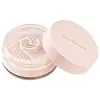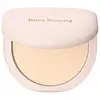Rare Beauty Always an Optimist Soft Radiance Setting Powder Versus Rare Beauty True To Myself Tinted Pressed Finishing Powder
What's inside
What's inside
 Key Ingredients
Key Ingredients

 Benefits
Benefits

 Concerns
Concerns

 Ingredients Side-by-side
Ingredients Side-by-side

Mica
Cosmetic ColorantCI 77220
Cosmetic ColorantSilica
AbrasiveC12-15 Alkyl Benzoate
AntimicrobialMagnesium Myristate
Nylon-12
1,2-Hexanediol
Skin ConditioningCaprylic/Capric Triglyceride
MaskingCaprylyl Glycol
EmollientCoco-Caprylate/Caprate
EmollientEthylhexylglycerin
Skin ConditioningMagnesium Stearate
Cosmetic ColorantPolymethylsilsesquioxane
Squalane
EmollientTocopherol
AntioxidantTocopheryl Acetate
AntioxidantPhenoxyethanol
PreservativeIron Oxides
CI 19140
Cosmetic ColorantMica, CI 77220, Silica, C12-15 Alkyl Benzoate, Magnesium Myristate, Nylon-12, 1,2-Hexanediol, Caprylic/Capric Triglyceride, Caprylyl Glycol, Coco-Caprylate/Caprate, Ethylhexylglycerin, Magnesium Stearate, Polymethylsilsesquioxane, Squalane, Tocopherol, Tocopheryl Acetate, Phenoxyethanol, Iron Oxides, CI 19140
Synthetic Fluorphlogopite
CI 77220
Cosmetic ColorantZinc Stearate
Cosmetic ColorantIsononyl Isononanoate
EmollientMagnesium Myristate
Oryza Sativa Bran Wax
Skin ConditioningSilica
AbrasiveDimethicone
EmollientBoron Nitride
AbsorbentMicrocrystalline Cellulose
AbsorbentEthylhexylglycerin
Skin ConditioningMica
Cosmetic ColorantSorbic Acid
PreservativeDimethicone/Vinyl Dimethicone Crosspolymer
Skin ConditioningTocopherol
AntioxidantHelianthus Annuus Seed Oil
EmollientCI 77492
Cosmetic ColorantCI 77491
Cosmetic ColorantCI 77499
Cosmetic ColorantCI 42090
Cosmetic ColorantCI 77742
Cosmetic ColorantCI 77891
Cosmetic ColorantCI 77007
Cosmetic ColorantCI 19140
Cosmetic ColorantSynthetic Fluorphlogopite, CI 77220, Zinc Stearate, Isononyl Isononanoate, Magnesium Myristate, Oryza Sativa Bran Wax, Silica, Dimethicone, Boron Nitride, Microcrystalline Cellulose, Ethylhexylglycerin, Mica, Sorbic Acid, Dimethicone/Vinyl Dimethicone Crosspolymer, Tocopherol, Helianthus Annuus Seed Oil, CI 77492, CI 77491, CI 77499, CI 42090, CI 77742, CI 77891, CI 77007, CI 19140
 Reviews
Reviews

Ingredients Explained
These ingredients are found in both products.
Ingredients higher up in an ingredient list are typically present in a larger amount.
CI 19140 is also known as Tartrazine. Tartrazine is a synthetic dye used in cosmetics, foods, and medicine to add a yellow color.
Tartrazine is created from petroleum and is water-soluble.
Some people may experience allergies from this dye, especially asthmatics and those with an aspirin intolerance.
Learn more about CI 19140We don't have a description for CI 77220 yet.
Ethylhexylglycerin (we can't pronounce this either) is commonly used as a preservative and skin softener. It is derived from glyceryl.
You might see Ethylhexylglycerin often paired with other preservatives such as phenoxyethanol. Ethylhexylglycerin has been found to increase the effectiveness of these other preservatives.
We don't have a description for Magnesium Myristate yet.
Mica is a naturally occurring mineral used to add shimmer and color in cosmetics. It can also help improve the texture of a product or give it an opaque, white/silver color.
Serecite is the name for very fine but ragged grains of mica.
This ingredient is often coated with metal oxides like titanium dioxide. Trace amounts of heavy metals may be found in mica, but these metals are not harmful in our personal products.
Mica has been used since prehistoric times throughout the world. Ancient Egyptian, Indian, Greek, Roman, Aztec, and Chinese civilizations have used mica.
Learn more about MicaSilica, also known as silicon dioxide, is a naturally occurring mineral. It is used as a fine, spherical, and porous powder in cosmetics.
Though it has exfoliant properties, the function of silica varies depending on the product.
The unique structure of silica enhances the spreadability and adds smoothness, making it a great texture enhancer.
It is also used as an active carrier, emulsifier, and mattifier due to its ability to absorb excess oil.
In some products, tiny microneedles called spicules are made from silica or hydrolyzed sponge. When you rub them in, they lightly polish away dead skin layers and enhance the penetration of active ingredients.
Learn more about SilicaTocopherol (also known as Vitamin E) is a common antioxidant used to help protect the skin from free-radicals and strengthen the skin barrier. It's also fat soluble - this means our skin is great at absorbing it.
Vitamin E also helps keep your natural skin lipids healthy. Your lipid skin barrier naturally consists of lipids, ceramides, and fatty acids. Vitamin E offers extra protection for your skin’s lipid barrier, keeping your skin healthy and nourished.
Another benefit is a bit of UV protection. Vitamin E helps reduce the damage caused by UVB rays. (It should not replace your sunscreen). Combining it with Vitamin C can decrease sunburned cells and hyperpigmentation after UV exposure.
You might have noticed Vitamin E + C often paired together. This is because it is great at stabilizing Vitamin C. Using the two together helps increase the effectiveness of both ingredients.
There are often claims that Vitamin E can reduce/prevent scarring, but these claims haven't been confirmed by scientific research.
Learn more about Tocopherol